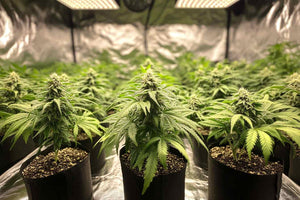Have you ever wondered about the different types of cannabis and how to distinguish them just by looking? Cannabis comes in various strains, each distinct in features and functions.
Indica, Sativa, and Hybrid – these aren't merely categories; they encapsulate the unique growth patterns, effects, and applications of cannabis. In the following sections, we'll explore the visual distinctions and practical effects of these prevalent cannabis types and offer some handy tips for recognizing them.
Cannabis Types Comparison

Indica Features:
Appearance Observations: Indica plants are notably compact and stout, typically standing between 3 and 4 feet tall. They feature broad, dark green leaves with blunt edges, contributing to their bushy appearance.
The flowers of Indica strains are dense and tend to cluster on the plant's short, robust branches, enhancing the bushy aesthetic. Adapted to cooler climates, Indica has a brief growth cycle that allows it to complete its growing and flowering phases swiftly before the onset of harsher seasonal changes.
Functional Effects: Indica strains are renowned for their high cannabidiol (CBD) content, a compound extensively researched for its therapeutic benefits, including pain relief, anxiety reduction, and insomnia treatment.
These properties make Indica a favorite among users seeking calming effects. Additionally, its shorter growing period is advantageous for commercial cultivation in cooler regions or places with limited growing seasons, making it a practical choice for growers aiming to optimize their yields and operational efficiency.
Sativa Features:
Appearance Observation: Sativa plants stand out with their impressive height, often reaching up to 12 feet or more. They feature slender leaves with sharp edges and a lighter shade of green compared to Indica varieties.
Sativas have a prolonged growth cycle and their flowers are more sparsely distributed along longer branches, giving the plant a leaner and more spread-out appearance. This type of cannabis thrives in tropical or subtropical climates, necessitating ample sunlight and a longer maturation period.
Functional Effects: Sativa strains are distinguished by their higher tetrahydrocannabinol (THC) content, which is responsible for psychoactive effects that can enhance creativity, energy, and cognitive activity.
This makes Sativa popular among those seeking a mental uplift or energy boost for social activities. Due to its long growth cycle and significant light requirements, Sativa is ideally suited for cultivation in warm, brightly-lit environments, making it a preferred choice for growers in such climates.
Hybrid Features:
Appearance observation: Hybrids are produced through artificial selection and mating of different Indica and Sativa varieties. The appearance characteristics are between the two and have greater variability.
Their height, leaf shape and flower characteristics depend on the proportion of Indica and Sativa in their genetic background. This diversity allows hybrids to adapt to a variety of growing conditions while combining the advantages of the male parents, such as the rapid growth characteristics of Indica and the high yields of Sativa.
Functional effects: The emergence of hybrids breaks the traditional boundaries between Indica and Sativa. They inherit the characteristics of the father and are optimized in some aspects. Hybrids can produce a variety of effects based on different breeding objectives to meet the needs of different consumers.
For example, some hybrids may combine the relaxing effects of Indica with the psychoactive characteristics of Sativa to provide a balanced experience. The chemical composition of hybrids is more diverse, which opens up wider possibilities for research into the medical uses of cannabis.
Identification skills

Let’s briefly sort out the key points of identifying cannabis types to ensure that you don’t get lost in this green maze. Here are some practical tips and tricks to help you improve your ability to identify cannabis species.
- Observe the leaves: Cannabis leaves are the key to identifying the species. The leaves of Indica are broad and thick and dark green in color; the leaves of Sativa are slender and light green in color; the characteristics of the leaves of Hybrid are somewhere in between.
- Analyze the plant structure: Indica varieties are usually short and stocky with dense growth; Sativa varieties are taller and thinner with open growth; Hybrid varieties may show these two extreme structural characteristics.
- Check flowers and resin: Flowers are the most important part of cannabis, and different types of cannabis vary in flower size, density, and resin content. Indica flowers are generally more compact and resinous; Sativa flowers are looser and less resinous; Hybrid flowers and resin characteristics are variable depending on their genetic background.
Mastering the knowledge of cannabis species identification is not only an inspiration for plant enthusiasts, but also an essential skill for professional growers. By recognizing and understanding the different visual characteristics, growth habits, and potential effects of cannabis, we can more accurately select and apply this versatile plant.
Note: The above content comes from VANQ

